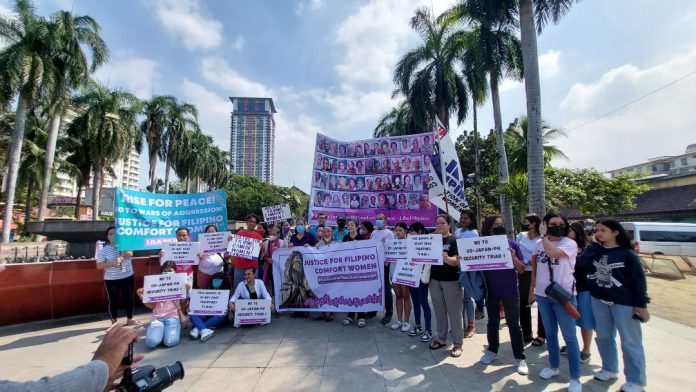Like other Filipina comfort women, Lola Hilaria Bustamante died still fighting without receiving justice.
Lola Hilaria passed away last Saturday, March 18, 2023 at the age of 97, ten days after the UN Committee on the Elimination of Discrimination against Women (CEDAW) released on International Women’s Day a decision which found that the “Philippines violated the rights of victims of sexual slavery perpetrated by the Imperial Japanese Army during the Second World War by failing to provide reparation, social support and recognition commensurate with the harm suffered.”
Lola Hilaria’s dreams of becoming a teacher crashed after she became a sex slave at the age of 16 in 1943. She was abducted by Japanese soldiers in Hermosa, Bataan and dragged her into a hut within a Japanese garrison and raped her.
She stayed in that hut along with other women for a year. During the day, they were forced to wash the soldiers’ clothes and cook the men’s meals. In the afternoon and evening, the men would come for them and sexually abuse them.
Lola Hilaria was one of the about 200,000 women from Korea, China, Burma, New Guinea, and the Philippines who were held in captivity and raped as part of one of the largest operations of sexual violence in modern history.
The victims have spent their lives in misery, having endured physical injuries, pain and disability, and mental and emotional suffering.
After more than five decades of silence, Lola Hilaria came out as one of the comfort women and joined Lila Filipina.
She was one of several plaintiffs who sued the Japanese government in 1993 at a Tokyo District Court. The Japanese Supreme Court dismissed the case several years after but Lola Hilaria continued in the fight for justice until her death.
The CEDAW Committee pointed out that Philippine government had failed to adopt appropriate legislative and other measures to prohibit all discrimination against women and protect women’s rights on an equal basis with men.
It noted that while Philippine war veterans, who are mostly men, are entitled to special and esteemed treatment from the government, such as health care benefits, old age, disability and death pensions , there was no such action with the comfort women.
The Committee found such actions as a breach of the Philippines’ obligations under the CEDAW as a State Party.
The Committee recommended that the victims must be provided with “full reparation, including recognition and redress, an official apology, and material and moral damages” proportionate to the physical, psychological, and material damage suffered by them and the gravity of the violation of their rights experienced.
Comfort women advocates Flowers for Lolas, Lila Filipina and Malaya Lolas supported the CEDAW recommendation on the preservation of Bahay na Pula, or the establishment of another space to commemorate the suffering of the victims and honor their struggle for justice.
On November 23, 1944,the women from Mapaniqui. Pampanga, were ordered to walk to the Bahay na Pula in San Ildefonso, Bulacan which became a barracks where they became victims of military sexual violence and slavery. Upon reaching the mansion, the soldiers dragged the women, ranging from 13 to early 20s, into dark rooms and took turns raping them.
A two-meter high “Lola” statue was installed in December 2017 along Baywalk, Roxas Boulevard in Manila. It was an unnamed woman wearing a traditional Filipino dress, blindfolded, with hands clutched to her chest.
The statue was dismantled by the DPWH on April 27, 2018, allegedly for a drainage improvement project, but seen as submission to protests from Japan. It was later declared missing in August 2019 when the artist, Jonas Roces, failed to deliver the statue for its reinstallation at the Baclaran Church.
Another comfort woman statue —of a young woman with fists resting on her lap—has been removed from the Catholic-run Mary Mother of Mercy shelter for the elderly and the homeless in San Pedro, Laguna, only two days after its unveiling in January 2019.
The remaining comfort woman statue owned by the late Nelia Sancho is now in its new home in Pandan, Antique.
Even if these are reminders of a painful past, the “Lola” statues honor the memory, courage and resilience of these Filipino women.
The Lola statues and the Bahay na Pula represent Filipino women’s dignity and stand as “a reminder that wars of aggression must always be opposed, and that sexual slavery and violence should never happen again to any woman, anywhere, at any time.”
From the more than 200 documented survivors in the late 1990s, less than 40 Filipino comfort women are still alive.
With Lola Hilaria’s death, the dwindling number highlights a sense of urgency for them to receive a formal, unequivocal public apology and just compensation from Japan as well as accurate historical inclusion while their voices can still be heard.
(Atty. Dennis R. Gorecho heads the seafarers’ division of the Sapalo Velez Bundang Bulilan law offices. For comments, e-mail info@sapalovelez.com, or call 09175025808 or 09088665786.)




